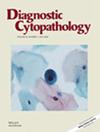The cytology features of neoplastic paratesticular lesions are mostly documented as case reports. Thus, we conducted a case report-based literature review to identify the characteristics of paratesticular neoplasms and tried to determine the significance of FNAC in these tumors.
The studies were searched using PubMed and Scopus. The quality assessment was done using the JBI critical appraisal checklist for case reports. The articles that received an overall rating of “Include” underwent data extraction. The data were extracted from the articles and analyzed.
We included 34 case reports from 33 published articles. The mean age of patients was 44.74 (13–85) years, and the most common clinical manifestation was scrotal swelling (70.59%, 24/34). Lesions were commonly observed on the right side (65.63%, 21/32), and the most common tumor site was epididymis (35.29%, 12/34). A total of 38.24% (13/34) cases were nonmalignant, and 61.76% (21/34) were malignant on the cytological diagnosis. The adenomatoid tumor (53.85, 7/13) was the most common nonmalignant tumor. Other entities were schwannoma, benign spindle cell neoplasm with atypia, nerve sheath tumor, lipoma, undifferentiated pleomorphic sarcoma, rhabdomyosarcoma, epithelioid sarcoma, liposarcoma, malignant rhabdoid tumor, pigmented neuroectodermal tumor of infancy and mesothelioma. Considering the malignant and nonmalignant groups, the sensitivity, specificity, and diagnostic accuracy of cytology were 95.00%, 84.62%, and 90.91%, respectively.
Cytopathologists should be familiar with the cytological features of various malignant and nonmalignant paratesticular tumors to prevent unnecessarily invasive surgical management. The current systematic review emphasizes usefulness of FNAC in the preoperative cytological identification of paratesticular tumors.


